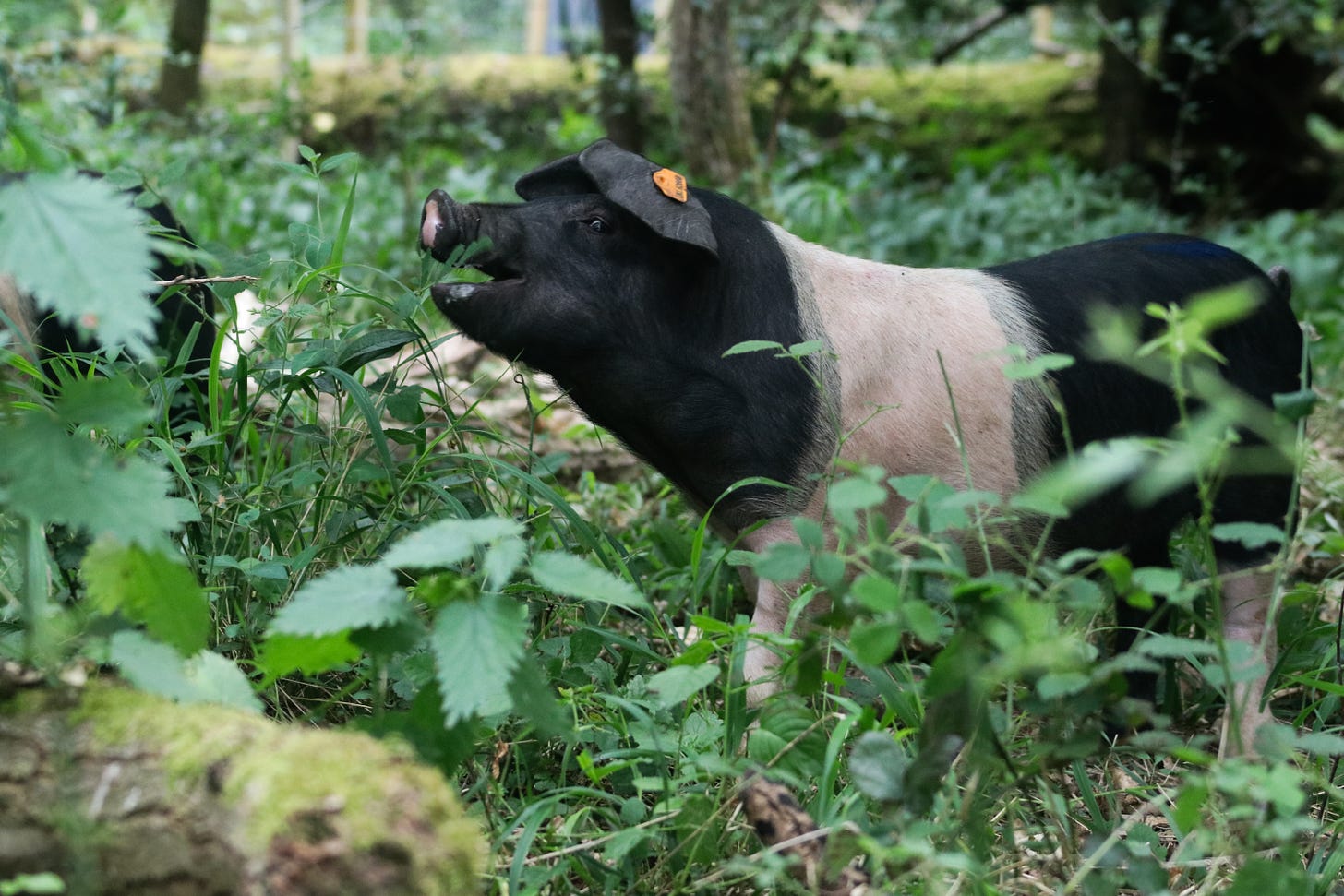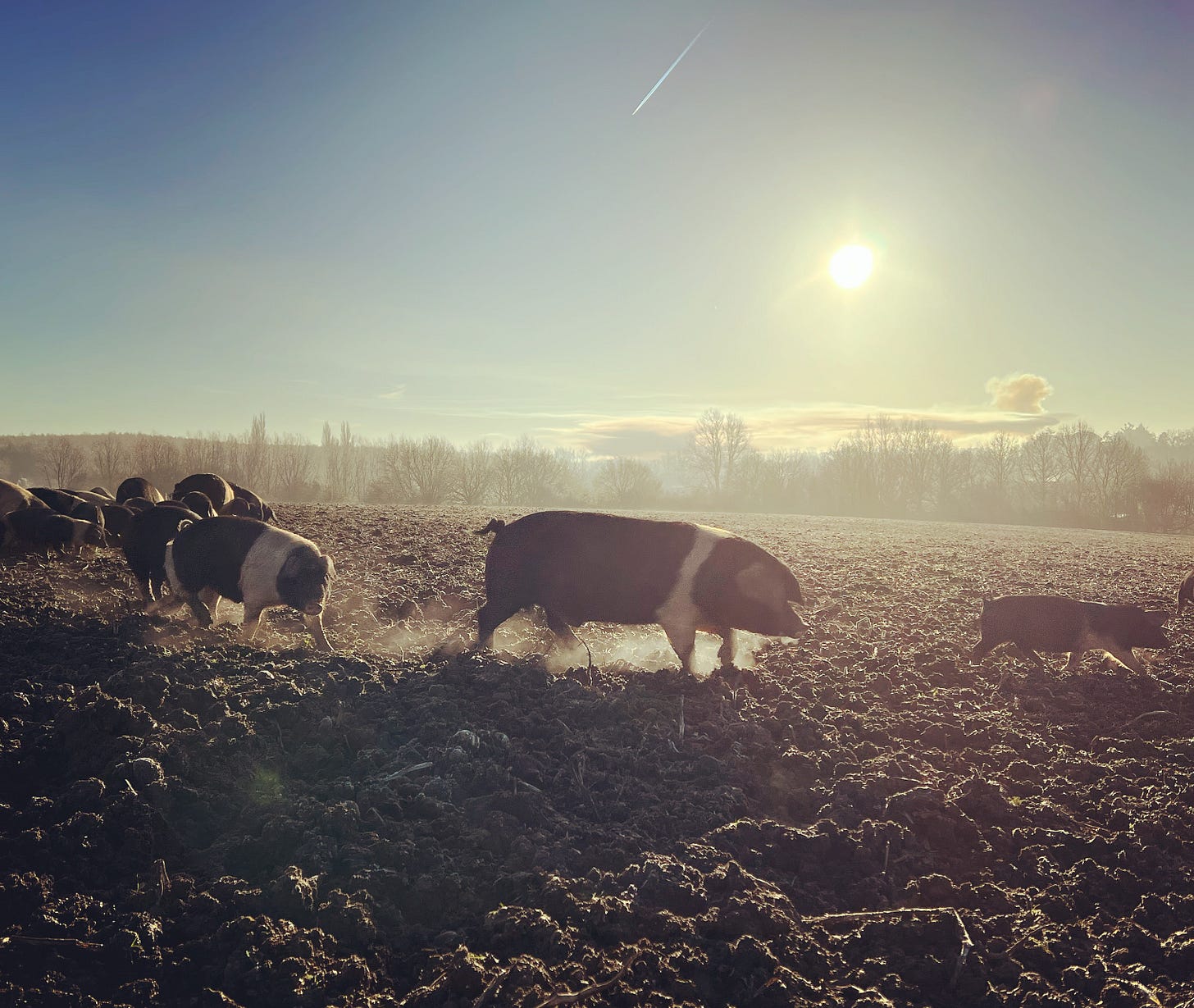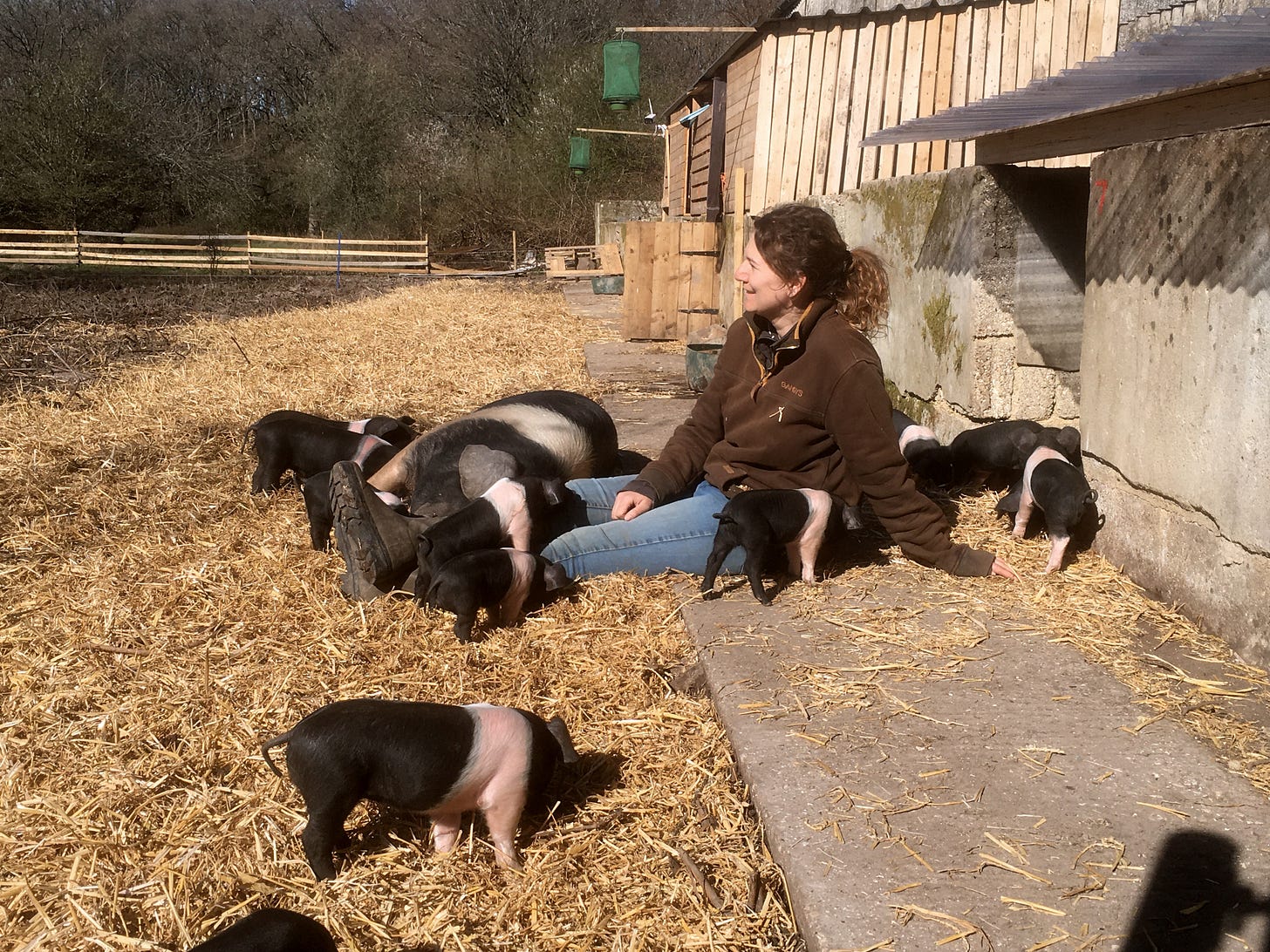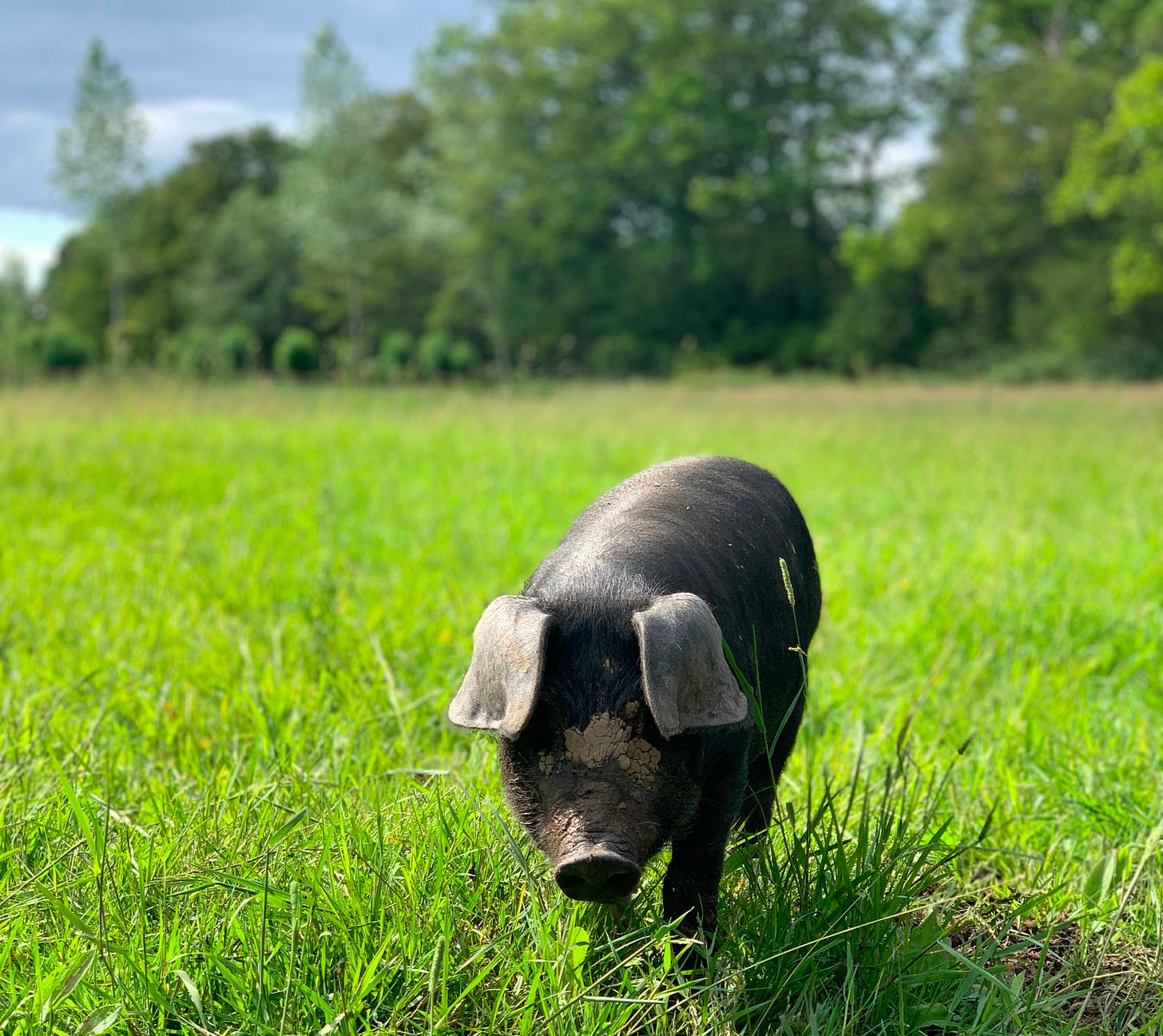Lessons from the Pasture
What My Pigs Taught Me About Real Sustainability
I didn’t grow up dreaming of farming, and I certainly never expected pigs to become my best teachers. But the first time I watched a group of Saddlebacks rooting through a woodland, sniffing out acorns, leaving behind a trail of upturned soil and wildflowers, I realised just how much we miss when we see pigs as nothing but troublemakers.
Back in 2020, when Matt and I started out, most farmers saw pigs as a risk. Too destructive, too messy, too much bother. But standing in a field, watching the pigs at work, I saw something different for our business, and for the land itself.
When we first started, most farmers weren’t exactly queuing up to have us as grazing tenants. Pigs had a reputation of being destructive, hard on the ground, rough on trees. But I quickly learned (and proved) that pigs, if well managed, are anything but a liability. They’re an asset.
Matt and I began with 5 acres of dense, neglected woodland. Land that hadn’t been touched in two decades, thick with invasive species and fallen trees. It was right next to a SSSI (Site of Special Scientific Interest), so regulations were tight. Natural England, wary of pigs, insisted we couldn’t bring in non-native straw or feed. They preferred cows, sheep, or ponies for woodland management. So, we moved our herd on. At the time, it was frustrating especially knowing what our pigs could do for that land.
Fast forward a few years, and I’m overjoyed to see the industry catching up. There’s a growing recognition of pigs’ positive role in regenerative agriculture. Integrating pigs into mixed systems to boost soil health, regenerate pastures, and increase biodiversity. Farms like The Woolly Pig Company in Scotland are leading the way with agroforestry systems, and even Natural England and The Woodland Trust now promote pigs for woodland management. The (paused) SFI schemes were even offering incentives for silviculture with pigs, a huge shift from the skepticism we faced early on.
My Regenerative Success Story: Pigs in the Arable Rotation
One of my proudest stories as a regenerative pig farmer was integrating our saddleback herd into an arable rotation. In November 2021 we moved the herd onto 50 acres of grazing on a mixed farm in Andwell. The field had just come out of potatoes and had soft soil, heavy machinery tracks, and the usual 10% of the crop left behind after harvest. Moving the pigs in wasn’t easy, we had about a week to get them settled before the weather turned, and the soil was so soft that machinery couldn’t get in without sinking.
But once the pigs were in, the benefits were immediate and mutual. For the farmer, the pigs cleared out the leftover potatoes, which would otherwise compete with the next crop be it cereals, grass, or herbal ley. Their manure, rich in nitrates, naturally fertilised the land, reducing the need for chemical inputs. As an experiment, we dumped piles of horse manure and waste straw to see if the pigs would spread it around as enrichment. They loved rooting through the warm mounds, especially in winter, but the coverage wasn’t as even as traditional muck spreading. (Tip: if you try this, use smaller piles scattered around the field for better results!)
For the pigs, it was enrichment heaven! Foraging for potatoes, digging into warm manure, and enjoying a free, additional food source. The best part? We got the grazing for free, providing a service to the farmer while giving our herd a winter home. The farmer benefited from reduced fertiliser costs, higher crop yields, and the bonus of selling cereals and straw to us for feed.
Come spring, the pigs moved onto pasture, and the arable fields were replanted this time with grass. What really amazed me was how quickly and thickly the pasture regenerated in the spots where the pigs had grazed most intensively. The contrast was striking the “pig-powered” patches bounced back faster and stronger than the rest. The power of the pig still amazes me.
Beyond My Farm: Research & Real-World Examples
It’s not just my experience, there’s a lot of robust research and on-the-ground evidence showing how pigs, when managed well, can be a force for good in all sorts of farming systems:
Biodiversity Boosters: Outdoor pigs break up soil, stimulate new pasture and tree growth, and create microhabitats for insects and wildflowers, boosting biodiversity (Soil Association).
Regenerative Rotations: Integrating pigs with cropping improves soil health and reduces artificial inputs essential for organic and regenerative farming (Agricology - Livestock and the Arable Rotation).
Nutrient Management: Rotational systems with pigs can help manage nitrogen and phosphorus pollution, reducing runoff and supporting cleaner waterways (White Rose Research).
Agroforestry Champions: At Knepp Estate, Tamworth pigs mimic wild boar, controlling scrub and creating a patchwork of habitats, directly increasing biodiversity (Knepp Estate). Integrating pigs into UK woodland systems can also bring farm profitability and animal welfare benefits.
Wetland Enhancement: Free-ranging pigs in floodplain woodlands create more diverse habitats, relevant for wetland edge management.
Arable Rotations: Pigs in arable systems incorporate organic matter, break up compacted soil, and reduce weed and pest burdens before cropping. After pigs move on, fields are often more fertile and resilient, supporting better yields.
Practical Tips for Integrating Pigs Sustainably
Match Stocking to Land: Don’t overload fields, rotate pigs regularly to avoid poaching and allow recovery. Short rotations are better!
Enrichment Matters: Use smaller piles of manure/straw for pigs to spread, rather than one large heap.
Watch Water Use: In summer, pigs need wallows to stay cool so monitor water sources to prevent waste.
Diversify Feed: Let pigs forage leftover crops or orchard windfalls its good for them and the soil.
Monitor Impact: Keep an eye on both bare patches and regrowth and adjust your rotation and intensity as needed.
Collaborate: Work with arable farmers for mutual benefit. Pigs clear fields, enrich soil, and reduce chemical needs.
Lessons Learned
Real sustainability, I’ve learned, isn’t about ticking boxes or chasing the latest buzzword. It’s about watching and listening. letting the land and the animals teach you what works (and what doesn’t). I’ve seen firsthand how pigs, when managed with care and intention, can revive tired fields, bring back wildflowers, and create new life where there was none. Sometimes, the smallest changes like a new rotation, a pile of straw, a few weeks’ patience, can spark the biggest transformations.
Labels and schemes are only as good as the hands and hearts behind them. It’s the daily decisions, the willingness to adapt, and the respect for the land that make the difference. Nature is always the best partner if we’re willing to work with it, not against it.
Join the Conversation & Support This Work
Now, I want to hear from you. Whether you’re a farmer, a gardener, or just someone who cares about where your food comes from, what does “real sustainability” look like in your world? Have you seen small changes make a big impact, or learned lessons from the land that surprised you? Share your stories, reflections, or even your questions in the comments.
If you enjoyed this article and want to see more stories, research, and practical insights about regenerative farming and food policy, consider subscribing for free to get new posts straight to your inbox.
If you’d like to support my work and help me keep sharing independent, on-the-ground perspectives, you can become a paid subscriber. Paid subscribers will get exclusive content, behind-the-scenes updates, and help sustain this community of real voices in food and farming.
The muddy boots, the early mornings, the setbacks and the small wins - these are the lessons I carry into every debate about the future of food and farming. If there’s one thing my pigs have taught me, it’s that real change doesn’t start in a boardroom or a policy document. It starts in the field, in the woodland, in the quiet moments when we pay attention to what the land is telling us. Let’s make sure those voices, the real, lived voices, are the ones shaping our future.
If just 5% of my readers tipped £1/$1 this essay would pay for itself in terms of time spent working on it.
Thanks for reading. H x








Wonder if pigs cold help in raising earthworms. Reduce any flies and help break down the soil to add their castings a detect fertilizer.
In the 1950's mum bought 10 pigs to clear a half acre impenetratable bramble patch. Result this patch produced all the vegetables to feed 12 of us for the next 40 years. I kept my own first herd of pigs in woodland in the 60’s.
Now I put 4 weaners into the cattle shed in spring, on top of the winters cow crap and by the time they are fat they have turned the cow manure into great compost.